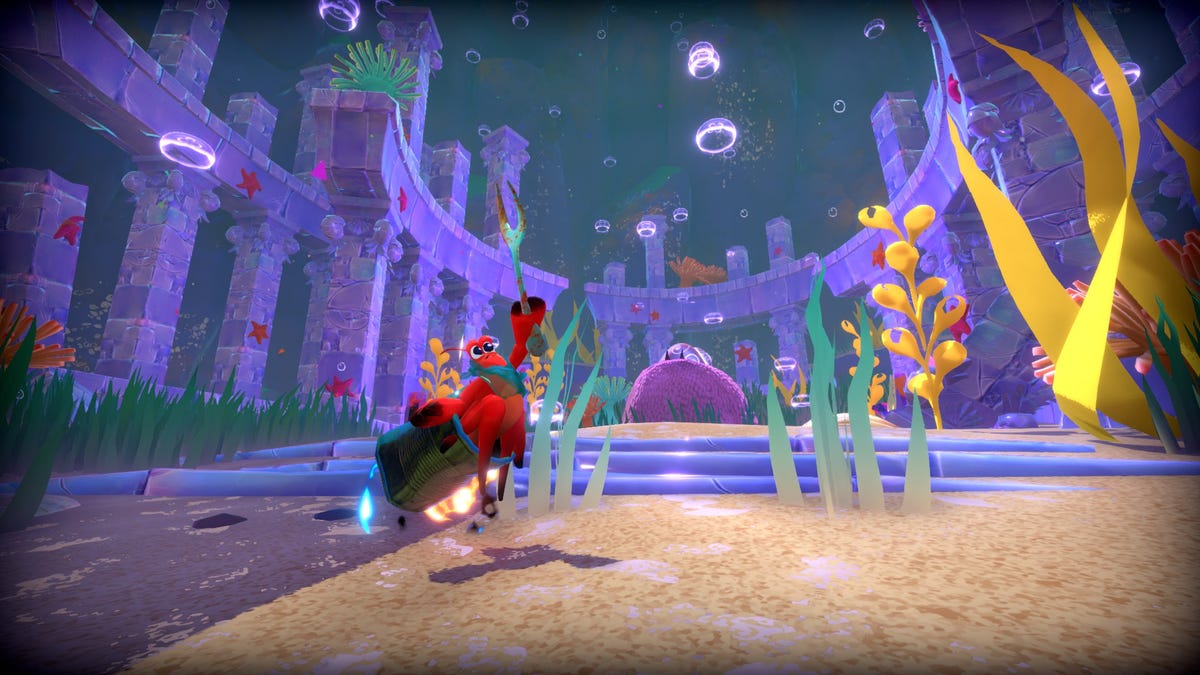Tech
Game Theory: SpongeBob Squarepants meets Dark Souls, somehow kind of rocks

Every Friday, A.V. Club staffers kick off the weekend by taking a look at the world of gaming, diving in to the ideas that underpin the hobby we love with a bit of Game Theory. We’ll sound off in the space above, and invite you to respond down in the comments, telling us what you’re playing this weekend, and what theories it’s got you kicking around.
Another Crab’s Treasure exists at a weird underwater crossroads: One of the cutest games to ever bear the “Soulslike” descriptor, the new action-RPG from fittingly named developer Aggro Crab operates betwixt the dark, terrifying apocalypses of the Dark Souls games, and the far cheerier (if still weirdly surreal) world of SpongeBob SquarePants. The game drops you into the multiple legs of tiny hermit crab Kril, who has to give up his aquatic Eremite ways after a sneaky loan shark takes his beloved shell, forcing Kril on an adventure that runs him straight into a world-endangering threat that pushes sentient sea-life into bouts of self-destructive and nigh-suicidal nihilism.
And if you felt that weird little hitch of whiplash just then, the shift in tone between aggressive punnery—Get it? Loan shark?—and grim violence, well, that’s kind of what playing Another Crab’s Treasure is like. Shot through with pro-environmentalist, anti-capitalist satire—not unlike Aggro Crab’s previous game, the very funny roguelike/gig economy riff Going Under—Another Crab’s Treasure sometimes feels like it’s going for multiple tones at once, not all of which jibe with each other. It doesn’t always work, this blend of fish puns and murder. But that’s okay, because what does work is the game’s approach to the slow, deliberate pace of Soulslike combat—once it lets you get to it, after a long opening sequence that very slowly introduces you to its combat mechanics.
That’s of a part with the game’s overall design, which, in line with the colorful visuals, aims to be a gentler introduction into the world of Souls-style fighting than the typical “Here’s our dying world, don’t go to the cemetery first, have fun dying” vibe. First, you learn how to hit—then how to block—and then how to cast spells, or use your combat skills. It’s all nice, in theory. What’s slightly frustrating about Another Crab’s approach to introducing these mechanics slowly, though, is that it leaves the opening hour or so of the game feeling almost painfully simplistic—to the point that, for most of the first major level, we found ourselves asking “Is this it?” That’s an especially dire problem for a game that launched Day One on Microsoft’s Game Pass, an environment where players—who’ve had to invest nothing but their time in acquiring the game—are probably more likely to bounce off of a game that doesn’t immediately catch them in its pincers.
Which would be a shame, because once the game settles into its groove, Another Crab’s Treasure reveals itself to be a very cool variation on the Dark Souls combat formula. Mostly, that means deliberately de-emphasizing the variability in attacking—you only have a single weapon, at least for the first several hours of the game we’ve played so far, with a relatively limited moveset—and a big focus on avoiding damage, generally by having Kril hide in various improvised shells you can find literally littering the landscape. With different looks, weights, and special moves attached, shells serve as both power-up and shield, and finding a new piece of garbage on the ground to crawl into can be a genuine thrill. That’s to say nothing of the satisfying feeling of tanking a hit from a big enemy by dipping your head down into a red Solo cup, or successfully parrying a strike from the boss while you have a fragile but powerful glass mason jar stuck to your ass. (Once you actually unlock the ability to parry, of course—see above about the frustrations of that slow-drip of basic gameplay tools.)
(This is also as good a time as any to note the game’s “assist” options, which allow the player to tune their difficulty in lots of different ways, something this genre has had a pretty complicated relationship with over the years. It’s an arena where Another Crab’s inherent gentleness is hugely to the game’s benefit, allowing players to slow down combat, remove penalties for dying, and—in the game’s most meme-worthy, but also genuinely hilarious, option—give Kril a giant gun that he can shoot any especially irritating monsters with.)
Making a “cute” Soulslike—don’t yell at us, the devs use the term in their own tooltips—was always going to be an exercise in paradox. Another Crab’s Treasure has all the hallmarks of the form, even the ones that can drive us to fits of madness. (There’s nothing quite like the feeling of semi-exquisite despair that sets in the fifth time you restart an area to go get your dropped souls—microplastics, here—again and realize you’re stuck in one of those “We go until the game kills me or I kill it” loops of bull-headed stubbornness.) And it would have been easy for Aggro Crab to just sail by on that weird disconnect, making what would have essentially been a novelty game, “Cozy Souls,” etc. Instead, they’ve found a new angle to the formula, creating fights that we’re generally interested in engaging with for their own sake—and not just because it’s fun to see a tiny, adorable crab guy parry murderous hits with an ice cream cone stuck to his butt.









